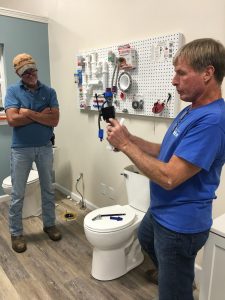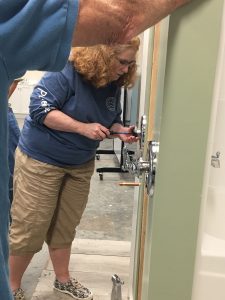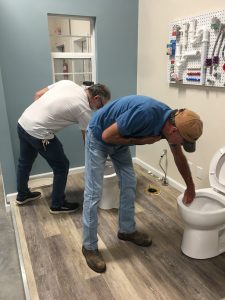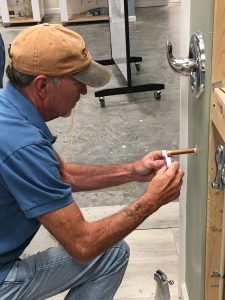News
Habitat for Humanity workshops teach basic DIY skills for homeowners
By: David Forster
Posted on:
MILLFIELD, Ohio (WOUB) — Jill Harman came because her upstairs toilet is sitting crooked and sliding off its base.
The toilet may be rocking and the screws that help hold it in place have come loose, Chuck Blyth tells her.
The bad news: The floor under the toilet may be rotting.
“That could be why your toilet’s a time bomb, and that gets into a lot of carpentry repair work, drying out, rebuilding,” Blyth says.

Blyth is leading the first in a series of home-repair workshops hosted by Habitat for Humanity of Southeast Ohio.
The workshops are intended to cover basic home maintenance and help people diagnose common household problems and perform simple repairs.
“I have had a couple times where I’ve had contractors come in and I’m writing the check, shaking my head, going, dammit, I could have done that if I just had this much more knowledge … this much more confidence,” said Molly Blair, Habitat’s training center coordinator.
The first workshop covered bathroom fixtures. The workshops are held weekly at Habitat’s headquarters in Millfield, and other topics include electrical, doors and windows, drywall, painting, mechanical maintenance, gutters and siding, bathroom and kitchen plumbing and roofing.
Habitat for Humanity workshops build confidence
Harman said her husband was recently diagnosed with cancer.
“I just figured this would be a great time to learn how to do some things for myself, be self-sufficient,” she said.
And while her sloping toilet may require some professional help, she learned other bathroom repairs she can easily do herself.
This is what drew Steve Poling to sign up. He’s looking to build more confidence when it comes to fixing things around the house.
“I just want to move around my house and be able to not be so afraid of everything, because right now it’s like, ‘Oh, something’s gone wrong. Oh crap, if I touch it, it’s going to get worse,’” he said.

Habitat for Humanity builds houses for lower-income residents, and the original idea for the workshops was to provide these new homeowners with some basic training for do-it-yourself maintenance and repairs.
“The goal is to teach the language of the system and have hands-on practical application in each workshop,” Blair said. “So if someone’s not confident in doing the repair, they can call a plumber and say, ‘Hey, my flapper isn’t working and I need a repair and I have a Mansfield toilet, or I have an American Standard toilet. This is the system I have.’ And they can intelligently speak to a contractor, which allows less room for some nefarious character to give them something they don’t need.”
Some of this training will become a requirement for new Habitat for Humanity homeowners, but the workshops are also open to anyone else with an interest. Two sessions are offered for each workshop, one in the afternoon and one in the evening.
After the first series of workshops is over at the end of November, it will start over again in January, and the plan is to keep rolling along like this with the series repeating several times a year so long as there’s interest.
Minerals are a problem
At the bathroom fixtures workshop, all eyes are on Blyth as he begins the evening with a deep dive into toilets.
He works his way through all the parts that can be maintained or replaced to keep this humble but hard-working appliance operating smoothly.
Mineral buildup is one of the biggest threats in this region given the hard water. It clogs up supply valves, flush valves, fill tubes, flappers and the holes lining the rim that release water during a flush and create the swirl effect that helps sweep everything down the bowl into the drain.

When a toilet starts flushing slow, often that’s the problem, he says. “And why replace a toilet when 20 minutes of chiseling takes care of the problem? You’d be amazed what comes out.”
Someone has a question about wax rings, which seat the base of the toilet to the floor flange: Her brother-in-law swears by stacking two of them together.
“Is that overkill?”
Not necessarily, Blyth says.
“Some toilets, that’s the only way they’ll seal,” he says, especially if the floor around the flange has been built up over the years and there’s a gap to fill.
Blyth switches to the shower and bath station for an overview of the plumbing network that brings hot and cold water to a mixing valve and from there to a tub spout and shower head.
Mineral deposits are the enemy here, too.
Throughout the workshop, Blyth keeps things conversational as he shares practical tips, such as how vinegar can be used to clear clogged shower heads.

After the initial overview, the room is divided into two groups for a closer look at the toilets and shower and tub fixtures and some hands-on experience.
Some practice applying teflon tape to the threaded fitting on a copper pipe to create a watertight seal with the tub spout (note: be sure to wrap it clockwise). Others try their hand at removing and reinserting faucet cartridges (tip: a firm, steady tug with pliers may be needed if it’s stuck).
The workshop runs a little over its scheduled 90 minutes, but nobody seems anxious to wrap things up.
At the end, Blair tells the group that while one workshop may not have them yet feeling confident enough to take on some of these repairs, she hopes the instruction helped demystify things a little.
“One of our hopes is that when people go home, you’re not so intimidated and you can look and discern what you’re looking at,” she says. “A lot of times these things in our houses, we just walk by them and then we’re surprised when they break and we don’t know what to do. But if we’re able to look a little more critically … a lot of it is common sense. Once you learn it, you’re like, oh, right, OK.”

